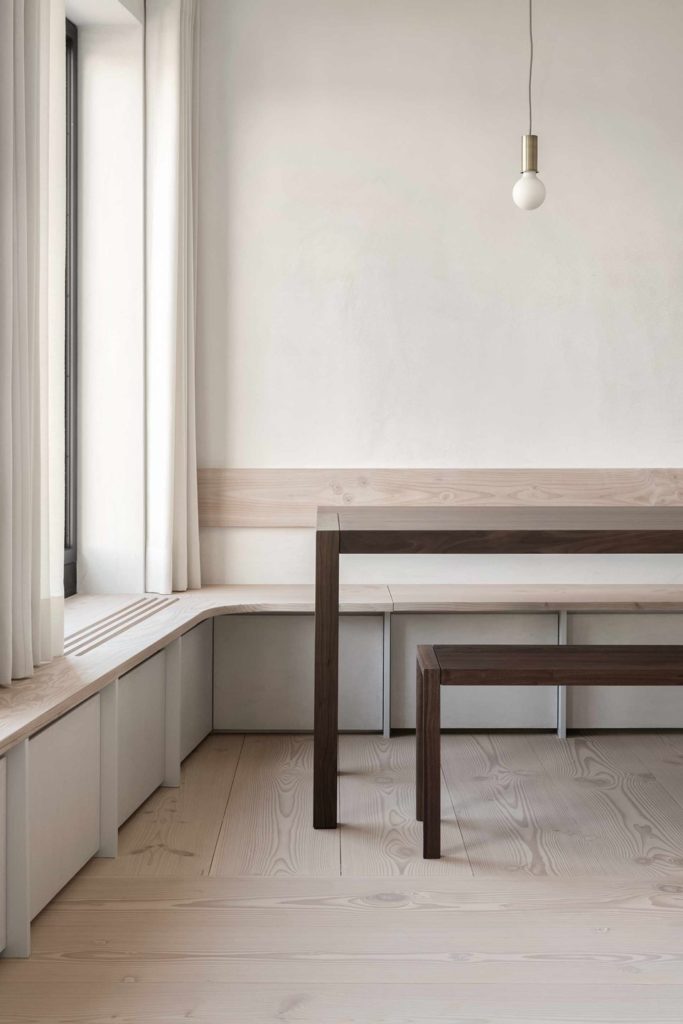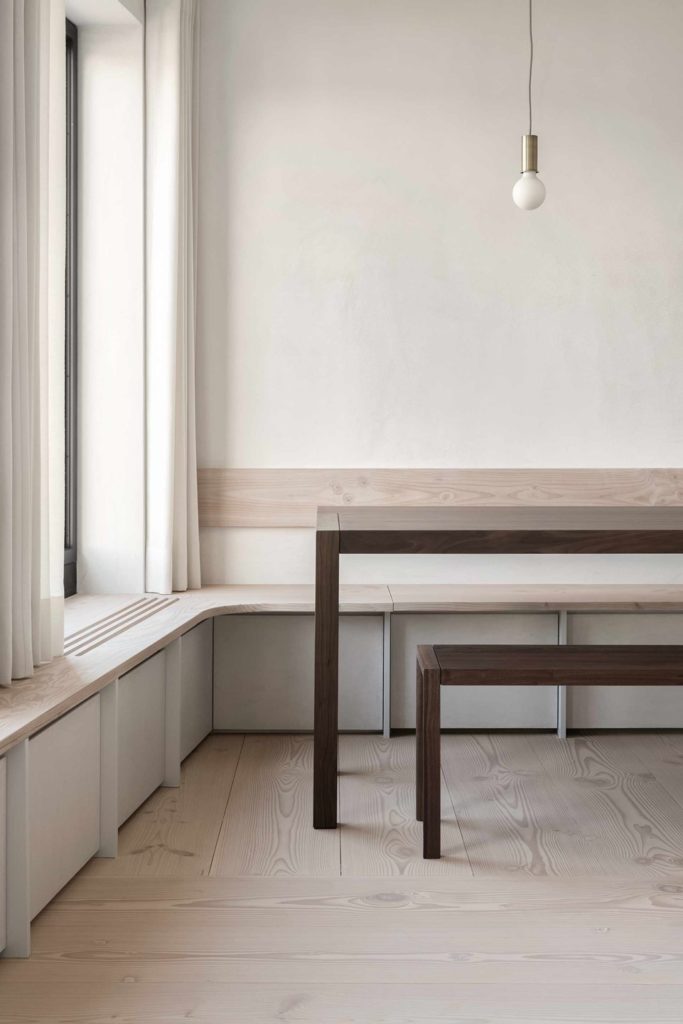
I’ve been trying to figure out what we want to do with the wood floors in the attic. If possible, I’d like to avoid sanding them down. I really like the patina they’ve developed over the decades, and I want to preserve the history of the floors as much as we can (we’ve found 3 more pieces of shrapnel since the last discovery). I’m also interested in using a traditional, natural finish that protects the wood, but is also really kind to it and doesn’t change the current color; something really safe.
I’ve been asking around for a few weeks, and our friend Gjisbert brought up the idea of a soap finish. Soap as in soap + water. He said it’s very safe and natural, and gives a really soft finish, and that it’s easy to clean (you just use more soap).
I’d never heard of finishing floors with soap. It sounds like a folktale! His advice sent me down an internet rabbit hole on soap finished floors, and it turns out that in some parts of the world, it’s a very common and effective way to finish and protect wood floors. Here’s what I’ve found:
From what I can tell the typical term for this kind of finish in English is: Danish Soap Finish. And if you look it up, there are quite a few helpful tutorials on it (see my resource links below).
Soap finished floors are common throughout Scandinavia. I’ve also heard about these types of floors from several Dutch friends (The Netherlands is not a Scandinavian country, but it sure seems to have a lot of design and style overlap with Denmark, Sweden, Norway, and Finland). All those gorgeous white-wood floors you’ve seen in nordic-style photos? They were probably featuring a traditional soap-finish. The floors in the top photo? They were finished with soap.
Ideally, you’ll use natural soap flakes for the soap + water mixture. From what I can gather, bar soap or liquid soap does not seem to work for this kind of finish. I’m not totally sure where to find natural soap flakes in France (I think it might be called savon noire — black soap — here). I’m also a bit confused about whether or not all soap flakes will work. Apparently they need a high fat content, but should contain no added oils.
Lots of resources mention using a lye wash first, before you apply the soap finish. The lye wash lightens the wood. We’re not trying to lighten the wood in the attic, so we would be skipping that step.
I’ve also seen several mentions of using a white-tinted soap if you want to whiten the floors even more. Again, we’re not going for a white finish, we’re trying to preserve the existing finish, so we would want to use a non-white-tinted soap.
The soap is mixed with water to make a thick mixture — like a porridge. Then it’s applied to the wood. It’s not supposed to be so wet that it forms puddles; any puddles should be wiped up with a dry cloth. The soap soaks into the wood. Several layers should be applied — I’ve seen at least three layers recommended, and up to six.
If the finish is wearing down, you just reapply. To maintain or clean the wood between applications, you use the same soap and water, but a much thinner ratio.
The problem I’ve encountered is that the tutorials I’ve found in English are all for furniture instead of floors. And pretty much all tutorials, in every language, seem to be focused on new or newly-sanded wood — which is not the situation I’m dealing with. I would love to find some directions specific to old, unfinished, un-sanded floors. I have so many questions:
How should I clean and prep the floors? How much soap will I need? What kind of soap to water ratio is best for floors (as opposed to furniture)? What are the best techniques for applying the soap finish to floors — should I use a mop? Or get down on the floor and apply it by hand with rags? Do I need to remove excess soap between coats? Or polish/sand it between coats? How many coats should I apply? How long do the floors need to dry between coats?
Here are the best resources I’ve found so far:
–This video is very helpful. It’s a woodworker who makes a thick sort-of paste from the soap and rubs it into his furniture. If you’re going to try this, don’t use the bar of castille soap that he features in the video, this guy tried it and the bar soap didn’t work, he had to order soap flakes.
-Not in the mood for video? Here’s a blog post about soap finishes.
-And here’s an article about it on Popular Woodworking.
-Here are floor instructions in Danish (use Google to translate the page), and here is another article in Danish that seems to have a different variation.
-Here’s another good Danish article on how to apply the soap. Try a search for “ludbehandling” if you want to find more.
–This company sells wood floor planks that have been treated with lye and soap (the picture at top is theirs). You can also read about them on Remodelista.
I’m still trying to research this and get as much information as possible, so if you have seen any other helpful videos (in English) or articles (in any language), I’d love the links.
Have you ever tried a soap finish for your floors? Or do you know someone who has? If you’ve seen soap-finished floors up close, what did you think? Were they really as soft as they say? Does the idea of a soap finish appeal to you? Or does it sound like too much work? I’d love to hear.

Oh, being a Finn I love these kinds of floors. It looks like it’s entirely possible to refinish old floors like this too. Lime wash isn’t good for oak floors, according to some websites I’ve seen, makes them yellow. I found this website from Finland.
The search word for this soap finish in Finnish is suopakuuraus. It seems that you’d only have to redo every 3-5 years depending on how much hard use the floors get. And the soap itself acts as a lightening agent. From what I understood there is a specific soap with linseed oil that is used for this purpose, mainly in liquid form these days.
I love a soap finish! I do some woodworking and often it. I whisk pure soap flakes with water and to create a thick paste. Then I use a soft cloth to apply one layer, let it dry completely (overnight), buff to a shine, and repeat until I have many layers built up. While it feels super buttery and looks beautiful, I would caution that it seems to yellow pretty significantly in a short period of time (over a few months). Many of my woodworking friends avoid it for this reason, or treat with lye first to mitigate the yellowing effect.
We are strongly considering soap-washed floors for our addition (new maple floors). I haven’t done much research yet, so thank you for all those links. I don’t want the yellow look and I am a little concerned how they would hold up with our 7 and 4 year-old kids. We often vacationed in Denmark when I was a child and it definitely influenced my taste.
I wonder if you’d be able to find some info on using suopakuuraus on old floors by contacting a historic building site in a Scandinavian country or Holland?
So interesting! I’m curious about the difference between a matte wax finish vs. a soap finish and whether one would preserve the patina better than the other? Also if one is more maintenance than the other? The results do look lovely for both!
This article walks through the steps for soap finishing pretty clearly (says at very bottom that the steps for application and maintenance are the same for floors as for furniture).
I found this article. It’s in Norwegian and it’s about using Lye and then floor soap, including the process. It has the names of the products used at the bottom which might be helpful.
A Belgium product, Rubio Monocoat, is what we used on our bare hardwood floors. We achieved the European look of our floors with this product. It is zero VOC, and comes in many beautiful colors. It has been on our floors for 3 years now and looks as good as the day it was applied. No sheen, flat finish. Easy to clean, just water.
We also have Rubio Monocoat on our hickory floors. It’s a lovely very natural look, and ours basically just looks like the wood itself. It doesn’t protect the wood from fading in high-sun areas, but I’m not sure anything does that, or maybe only something that gives a very heavy coating, which we didn’t want.
Here is a Dutch article to run through google translate. I do think the floor needs to be sanded though for the soap to ‘catch’. But maybe try it? You can always sand later if it doesn’t work!
This is the product.
In Sweden it is very common in old houses to have this kind of floors. And today many people use the same technique. Here is a popular site for building preservation with a tutorial.
Good luck!
I live in Denmark where soap finish is common. It looks besutiful but is not simple to maintain. You need to consistently remove your shoes indoors and still need to refresh the soap weekly. A similar look comes from oil with White pigment. This treatment is much easier to maintain.
Also living in Denmark, came across this while searching for how to repair damage to the floor. I’ve been renting an apartment with soap finished floors that are either fir or pine (soft wood). I’m not sure how much is the soft wood and how much is the soap finish, but I have never had felt so much anxiety over floors. I never wear shoes inside and am pretty neurotic, but in just two months the floor has over a dozen extremely visible scratches and tons of small dents. I have a cat, but the cat isn’t destructive, the scratches are just from normal walking around and I have no idea what the dents are from. I have no idea how people live with these floors if you have pets, children, or any kind of social life beyond tiptoeing in socks.
Do you have any ideas of where I can read about maintenance for wood floors or where to get this oil with white pigment? I really want to do this finish in our new house but I have three boys and I’m not sure high maintenance is a good idea for us 😭